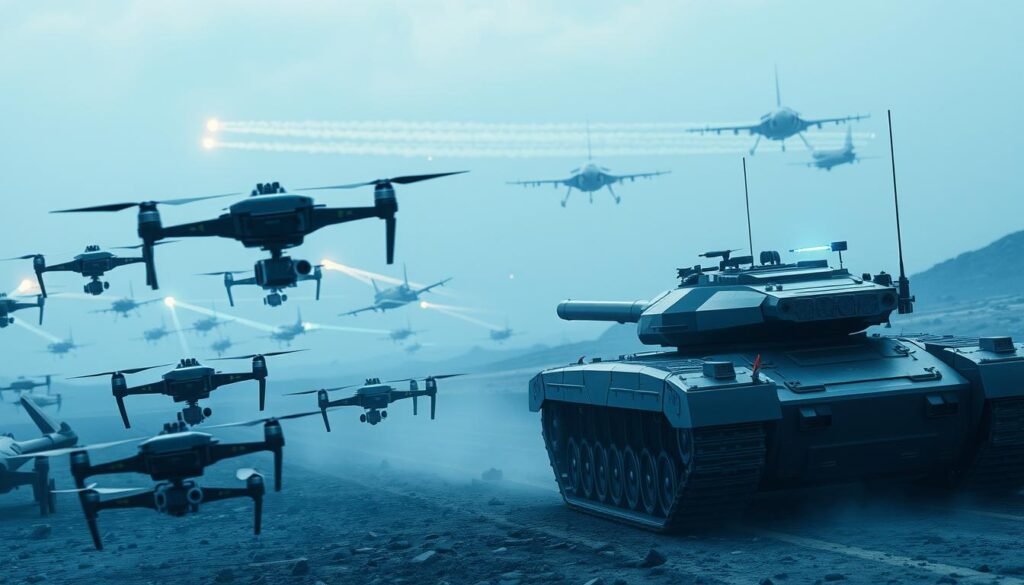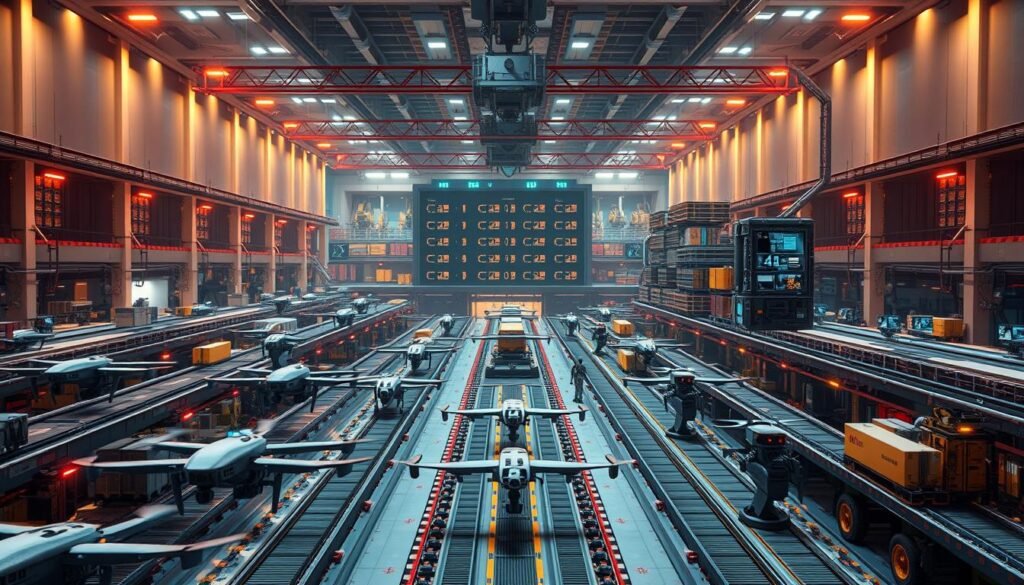War at the Speed of AI: How Artificial Intelligence Is Redefining Military Tactics.
A report from the Center for a New American Security shows AI can make decisions in seconds, not hours. In today’s digital battles, AI, ML, and GenAI are key, not just helpers. They drive quick decisions, improve surveillance, and control autonomous weapons, changing war.
The fast and precise actions of war at the speed of AI are shaking up how we fight. It’s a big change in how we approach and carry out modern conflicts.
Key Takeaways
- AI-powered technologies have evolved to become critical in military strategy and tactics.
- Real-time decision-making is greatly improved with AI.
- Autonomous weapon systems and advanced surveillance are now key to modern warfare.
- The use of AI in military systems is changing how conflicts and engagements happen.
- The chance to cut decision time from hours to seconds highlights the need for strong AI in the military.
The Rise of AI in Military Strategy
AI was once seen as science fiction. Now, it’s a key part of military strategies worldwide. It helps with big data, better surveillance, and planning. This is because AI can do things faster and better than humans.
Economic needs, tech competition, and the desire for a military edge push AI adoption. This is true for defense sectors everywhere.
From Science Fiction to Reality
The use of AI in modern warfare is a big change from old tactics. It brings science fiction to life. Advanced AI and machine learning help militaries use huge amounts of data fast.
This makes strategies more accurate and flexible. The impact of AI in war is huge, bringing new levels of efficiency and precision.
Driving Forces Behind AI Adoption
The future of warfare technology is driven by the need for military strength. Countries are spending a lot on AI to boost their military power. This is due to economic and technical reasons.
The push to use AI in defense is to stay ahead of rivals. It meets the complex needs of today’s battles.
AI-Powered Surveillance Systems
In today’s military, AI-powered surveillance systems are key. They use data from satellites, drones, and sensors to watch over large areas. This lets them spot enemy movements and threats quickly.
The use of AI-driven warfare strategies makes the data useful. AI processes the data quickly, helping commanders make quick decisions. This gives a big advantage on the battlefield.
These AI-powered surveillance systems keep getting better. They learn from new threats and environments, getting better over time. This is key for staying safe and winning in changing battles.
As we use more AI-driven warfare strategies, AI’s role in the military will grow. It can gather, analyze, and act on data faster than ever before. This could change how wars are fought, giving a strategic edge.
Autonomous Drones: Revolutionizing Air Warfare
In the changing world of war, autonomous drones are making a big impact. They use *innovations in AI and national security* to change air warfare. They bring big advantages.

Unmanned Aerial Vehicles (UAVs)
Unmanned Aerial Vehicles (UAVs) lead this change. They have the latest *UAV technology*. They do missions like watching targets and gathering information, all without putting people in danger.
They keep sending important data. This helps in making quick decisions and makes things run smoother. UAVs like the MQ-9 Reaper and the RQ-4 Global Hawk are key in military actions around the world. They show how AI helps in air battles.
Drone Swarms and Their Tactical Advantages
Drone swarms are another exciting development. They use *innovations in AI and national security* to work together. They can attack in many ways and confuse the enemy.
This new way of fighting is changing how wars are fought. It shows how important *innovations in AI and national security* are for the future of air battles.
Enhanced Situational Awareness
The use of advanced technology in defense has greatly improved our ability to understand situations. AI systems use data from satellites, ISR feeds, and battlefield communications. They combine this information into a clear picture of the situation. This is very helpful in fast-changing combat situations where quick and smart decisions are key.
AI takes it further by making sense of this data and giving useful insights. These ai-enhanced warfare strategies help commanders see the situation quickly and accurately. They can then make smart moves to avoid risks and find chances to win.
AI also helps in better communication among different units and allies. With better situational awareness, everyone involved in a mission can work together smoothly. This leads to better teamwork and strategic wins that were hard to get before.
For example, AI helps create detailed dashboards that show the battlefield. These dashboards use live data and analytics to give commanders up-to-date info. They show where troops are, where the enemy is, and what the environment is like.
| Data Source | Integration | Benefits |
|---|---|---|
| Satellite Imagery | Visual and Analytical Integration | Real-time Terrain and Enemy Position Data |
| ISR Feeds | Sensor Data Fusion | Enhanced Reconnaissance and Surveillance |
| Battlefield Communications | Unified Communication Networks | Coordinated Maneuvers and Efficiency |
In short, using AI and technology in defense has greatly improved our situational awareness. This gives us a strategic advantage in modern warfare. With ai-enhanced warfare strategies, commanders can make quick, informed decisions. This leads to successful missions and better operational results.
Predictive Threat Analysis
Defense strategies are changing fast, thanks to predictive threat analysis with AI and machine learning. This new tech lets us see and stop threats before they happen. It’s faster and more accurate than ever before.
Machine Learning in Threat Assessment
Machine learning in military operations makes threat assessment better. It looks at huge amounts of data, from past battles to current ones. This helps find patterns and guess what the enemy might do next.
So, defense teams can plan and act before a threat shows up. This is thanks to actionable intelligence from AI.

Real-Time Decision Making in the Field
Predictive threat analysis tools help make quick decisions in the field. AI gives commanders fast insights. This is key for making smart, fast changes in strategy and tactics.
Also, AI weapons development has given troops better awareness. This means they can respond quickly and well to changing threats.
Here’s how traditional threat assessment compares to AI-driven predictive threat analysis in the military:
| Aspect | Traditional Threat Assessment | AI-Driven Predictive Threat Analysis |
|---|---|---|
| Data Processing Speed | Slow | Fast |
| Accuracy | Variable | High |
| Real-Time Capabilities | Limited | Extensive |
| Situational Awareness | Moderate | Enhanced |
| Decision-Making Speed | Delayed | Immediate |
AI in Modern Naval Operations
As we move into the era of military AI, we see big changes in naval operations. Technologies like unmanned maritime vessels (UMVs) and AI-enhanced sonar systems are leading the way. They bring new levels of security and efficiency to the seas.
Unmanned Maritime Vessels (UMVs)
Unmanned maritime vessels are key in ai in naval warfare. They do jobs like finding mines, watching underwater, and tracking enemy subs. This means no sailors have to risk their lives in dangerous places.
AI-Enhanced Sonar Systems
AI has also improved sonar systems in the military. These systems use smart algorithms to spot and track underwater threats better than ever. With AI, naval forces can stay ahead of dangers, finding threats before they become a big problem.
The use of AI in sonar is a game-changer. It lets us detect and respond to threats in real-time, making our seas safer.
| Aspect | Unmanned Maritime Vessels (UMVs) | AI-Enhanced Sonar Systems |
|---|---|---|
| Primary Function | Mine detection and underwater surveillance | Threat detection and classification |
| Operational Advantage | Extended operational duration in hostile environments | Unprecedented accuracy and threat assessment |
| Risk Mitigation | Minimizes human personnel exposure | Real-time responses to underwater threats |
AI’s Tactical Toolkit: Beyond Human Limits
The military world is changing fast, thanks to artificial intelligence (AI). AI can process data quickly and accurately, giving a strategic advantage. It’s used in cyber warfare, planning, and logistics, making it key in modern battles.
AI helps commanders make fast, smart decisions. It looks at lots of data and gives insights quickly. It also predicts threats and suggests how to act.
AI tools also improve planning by running simulations and models. They consider many factors, something humans can’t do alone. This shows how AI is changing military strategies.

AI is changing how the military manages logistics and supplies. It predicts when equipment needs maintenance, keeping things running smoothly. It also makes sure supplies get where they need to go, even in tough places.
These AI tools do more than just improve what we can do. They open up new ways to fight and plan. As we use more AI in the military, we can do more than we thought possible.
AI-Driven Logistics and Maintenance
AI has changed how we manage military logistics and maintenance. It helps us send the right supplies to troops at the right time, even in tough places. It also predicts when military equipment might break down, so we can fix it before it fails.
Having efficient military supply chains is key to keeping our forces strong. AI helps us see and solve logistical problems before they happen. This shows our dedication to keeping our troops ready and flexible with AI.
Predictive Maintenance for Military Hardware
Predictive maintenance is changing how we care for military equipment. It uses smart algorithms and data to spot problems before they happen. This way, we can fix things before they break, keeping our gear ready for action.
Optimized Supply Chains in Conflict Zones
Supply chains are vital for supporting our troops in war zones. AI helps us plan and manage these chains better. It considers things like terrain and weather, making sure supplies get where they need to go fast.

AI in logistics and maintenance makes our military stronger and more efficient. By using these technologies, we improve our ability to respond to changing battlefield needs.
Understanding The Implications of AI in Conflict
Artificial intelligence is changing how we fight in modern warfare. It brings new ways to improve tactics, predict threats, and use autonomous weapons. These changes are altering our views and actions in defense.
AI’s role in defense is huge. It makes unmanned systems and improves logistics. This leads to quicker, more accurate military actions.
But AI also raises big questions. It makes us worry about the ethics of autonomous systems. It’s key for military leaders and governments to think about these issues. They must consider AI’s role in starting or worsening conflicts.
| Aspect | Implications |
|---|---|
| Tactical Enhancements | AI improves precision and coordination in military operations. |
| Strategic Advantages | Enhanced situational awareness and real-time decision-making. |
| Geopolitical Shifts | Potential for reshaping power dynamics among nations. |
In conclusion, it’s vital to grasp the implications of AI in modern warfare for global security. As we use these technologies, finding a balance between tech and ethics will shape the future of conflict.
Artificial Intelligence Warfare: Ethical and Legal Considerations
As we explore the fast-changing world of AI in warfare, we must look closely at the ethical and legal challenges it brings. We focus on the autonomy of weapons and creating global laws to handle these new technologies well.
The Debate Over Autonomous Weapons
The autonomous weapons debate raises big ethical questions in AI warfare. A main worry is who is to blame when these systems cause harm without human control. This issue highlights the need for strict rules to stop misuse and follow global humanitarian laws.
Legal Frameworks and International Guidelines
Creating strong legal frameworks and global rules is key to solving AI warfare’s ethical problems. Laws like the Geneva Conventions must be updated for AI. This way, we protect civilians and reduce AI’s risks in war. It’s important to tackle legal issues to balance innovation with preventing AI misuse in conflicts.
War at the Speed of AI
AI is changing how we fight in modern warfare. It’s making our military operations faster and more effective. AI systems help us make quicker, smarter decisions in complex situations.
This new way of war is all about speed and efficiency. AI helps us plan and execute missions quickly. It can analyze huge amounts of data to find threats and suggest actions fast.
AI also lets us adapt quickly to changing battlefields. It learns from past battles, making our strategies better over time. This gives us an advantage over our enemies.
As AI gets better, our military actions will get faster. This means we can make decisions and take action almost right away. It makes us more effective in combat and keeps our soldiers safer.
The possibilities with AI in war are endless. We’re on the verge of new strategic possibilities. From drones to predicting threats, AI is changing warfare for the better.
Military AI Advancements in Different Nations
Countries around the world are racing to improve their military AI. They use technology to boost their defense. Each country has its own way of doing this, showing their unique strengths and goals.
The United States and Project Maven
The United States is at the forefront with Project Maven. This program uses AI to quickly sort through data from drones and other tools. It helps find and identify objects fast, giving the military a big advantage in real-time.
India’s AI-Powered Defense Systems
India is using AI in all parts of its military. It wants to improve how it watches, gathers information, and makes decisions. India is also working on AI for better maintenance, logistics, and even self-driving systems.
China’s Investment in AI for Surveillance
China is putting a lot of money into AI for watching over its territory. It uses AI to look at big data, track people, and guess where threats might come from. This makes China a big player in military AI worldwide.
| Country | AI Initiative | Objective |
|---|---|---|
| United States | Project Maven | Automated data analysis for real-time intelligence |
| India | AI-Powered Defense Systems | Enhanced surveillance and decision-making |
| China | AI for Surveillance | Comprehensive monitoring and threat prediction |
The Future of Military AI Technologies
The future of military tech is exciting, thanks to quantum computing and AI. These advancements will make military operations safer and more efficient. They will change how we handle conflicts in the future.
Quantum Computing and Secure Communications
Quantum computing is set to change secure communications in the military. Quantum computers can handle huge amounts of data at once. This means they can create top-notch encryption, keeping military secrets safe.
Also, quantum computers make decisions super fast. This is key in situations where time is everything. Using quantum computing in defense can help us react to threats quicker.
AI in Cyber Defense and Electronic Warfare
AI is making cyber defense systems better. These systems use machine learning to spot and stop cyber attacks fast. This keeps military operations safe from cyber threats.
AI is also changing electronic warfare. AI tools can mess with enemy communications and radar. They also give us real-time info, giving us an advantage on the battlefield. As we go forward, AI will be key in keeping us ahead in military battles.
Conclusion
AI is changing how we think about war. It’s making surveillance and threat analysis better. It’s also changing how we use the sea, manage supplies, and keep things running.
AI makes decisions faster and more accurately. This is a big deal for war strategies. But, we need to think about the ethics and laws of AI in war.
Autonomous weapons and surveillance need rules. We must make sure they help keep the world safe, not harm it. Finding the right balance between tech and ethics is key.
AI is going to change how we fight and defend ourselves. If we use AI wisely, it can make the world safer. How we use AI will shape the future of war and keep everyone safe.




